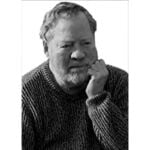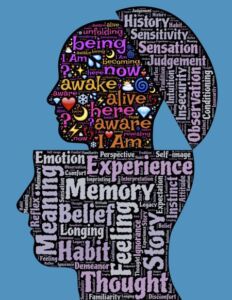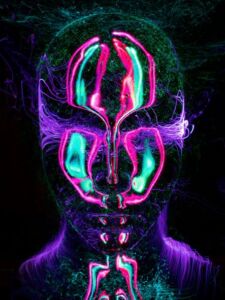by David Ritchey, Ph.D.
 In this paper, it is argued that a difference in neurological structuring, labeled “anomalous cerebral dominance” by neurologist Norman Geschwind, facilitates the experiencing of alternate states of consciousness and of other lives. It is suggested that all of reality, including the human brain, is organized holographically and that what quantum physicist David Bohm speaks of as the “implicate order” is the source of other-life experiences. Both this article and the Goldberg article which follows present some innovative theories linking the experiencing of past lives with the speculations of quantum physics.
In this paper, it is argued that a difference in neurological structuring, labeled “anomalous cerebral dominance” by neurologist Norman Geschwind, facilitates the experiencing of alternate states of consciousness and of other lives. It is suggested that all of reality, including the human brain, is organized holographically and that what quantum physicist David Bohm speaks of as the “implicate order” is the source of other-life experiences. Both this article and the Goldberg article which follows present some innovative theories linking the experiencing of past lives with the speculations of quantum physics.
Introduction
Alternate states of consciousness (ASC’s) play a significant role in the experiencing of past lives, whether those experiences occur deliberately in the structured environment of a therapist’s office or spontaneously in everyday life. When past-life “flashbacks” do occur spontaneously, they can be quite unsettling and are often regarded as one of what Stanislav Grof (1989) calls “spiritual emergencies.” Other experiences which Grof also calls spiritual emergencies include: shamanic crises, awakenings of Kundalini, episodes of unitive consciousness (“peak experiences”), psychological renewal through return to the center, crises of psychic opening, communication with spirit guides and “channeling”, experiences of close encounters with UFOs, and possession states. All of these experiences are included in the category of phenomena which Grof calls “transpersonal experiences.”
It is my position that certain innate neurological differences which the late Norman Geschwind (1985), a professor of neurology at Harvard Medical School, called “anomalous cerebral dominance,” are conducive to an individual’s entering alternate states of consciousness which facilitate past-life recall and other transpersonal experiences.
Anomalous Cerebral Dominance
In standard cerebral dominance (SCD), there is a hemispherical asymmetry with portions of the left cerebral hemisphere, especially in the area of the planum temporale (the upper surface of the back portion of the temporal lobe) being larger and the Sylvian fissure (which lies above the temporal lobe) being longer than in the right hemisphere. In cases of anomalous cerebral dominance (ACD), which constitute 30% to 35% of the population, this asymmetry is non-existent and, occasionally, reversed. Additionally, in ACD, there tends to be an enlargement of the corpus callosum, the primary bundle of fibers connecting the two hemispheres of the brain. Functionally, ACD implies a greater than normal participation of the right cerebral hemisphere in those functions which are usually under the purview of the left hemisphere—specifically language and motor control for handedness. Anomalous dominance for language, Geschwind suggested, is responsible for developmental learning disorders, and there are four primary markers for this anomalous dominance: (1) left-handedness, (2) right-handedness with left-handed first-degree relatives (parents, children, siblings), (3) right-handedness with developmental learning disorders, and (4) right-handedness with first-degree relatives having developmental learning disorders.
eschwind argued that the major cause of ACD is a delayed development of the left cerebral hemisphere with a concurrent enhancement in the development of the right cerebral hemisphere. This delay, he claimed, is caused by a heightened level of sex hormones, especially testosterone, in utero, and, to a lesser extent, in infancy and early childhood. Additionally, he stated, the testosterone effect can cause immune disorders (such as allergies, eczema, ulcerative colitis, insulin dependent diabetes, and lupus erythematosus) by delaying the development of the thymus and other immune system organs. ACD is also associated with neurological disorders of childhood (such as dyslexia, stuttering, attention deficit disorder, and Tourette’s syndrome), neurological disorders of adulthood (such as schizophrenia, certain types of epilepsy, and Alzheimer’s disease), birth defects (such as cleft palate, harelip, scoliosis, and wandering eye), chromosomal abnormalities (such as Down’s syndrome), and a host of other miscellaneous phenomena such as hypopigmentation, homosexuality, twinning, a lowered life expectancy, sleep disorders, low serotonin levels, and special talents in areas such as music, mathematics, spatial relations, chess, and athletics. It is, however, the ability to enter alternate states of consciousness and have transpersonal experiences (such as past-life recall) that is of greatest interest for the purposes of this paper.
 Alternate States of Consciousness
Alternate States of Consciousness
ACD individuals are found in elevated numbers among the ranks of mathematicians, physicists, architects, chess players, musical composers, and artists (Geschwind, 1985), all of whom are said to be holistic (or visual) thinkers with unusual capacities for vividness of mental imagery. Creative geniuses are, in many cases, known for their tendencies to enter alternate states of consciousness involving vivid mental imagery while engaged in the creative process, two examples being Beethoven’s state of “rapture” and Aldous Huxley’s “deep reverie.” Indeed, Hans Selye (Pearce, 1971) wrote that every really important scientific discovery that he knew of occurred in an alternate state of consciousness, examples being Einstein’s development of the theory of relativity while imagining himself riding on a beam of light, and Kekule’s conceptualization of the benzene ring while daydreaming about a snake swallowing its own tail.
Vividness of mental imagery contributes to the capacity for “psychological absorption” (Telegren & Atkinson, 1974), or imaginative involvement, which Josephine Hilgard (1965) tells us is the personality trait that, above all others, correlates with hypnotizability. Ernest Hilgard (1965) provides us with a dissociative model of hypnosis, and it is psychological dissociation which is the mechanism through which alternate states of consciousness become accessible. Indications are, then, that ACD individuals are likely to have facility at entering alternate states of consciousness, and are therefore more likely than the norm to have past-life and other transpersonal experiences.
In thinking about these psychological processes, it is important that we not fall prey to the common tendency to think of all forms of dissociation as being “disorders.” We should, rather, adopt Braun’s “BASK Model” (1986) definition in which dissociation is defined as “a process whereby an individual separates behaviors, affects, sensations, and/or knowledge from the mainstream of normal waking consciousness.” Such a definition allows us to consider alternate states of consciousness without automatically pathologizing them.
An individual whose capacity for imaginative involvement, whose vividness of mental imagery is so strong that he is able to create imagery which is, subjectively, as “real” as objective reality, may experience difficulty in differentiating imagery as an internal event from perception as an internal representation of an external event. This confusion of an imagined stimulus with a physical stimulus, known as the “Perky effect” for a classic experiment in perception conducted by the psychologist C. W. Perky in 1910 (Baker, 1992), is the stuff that “hallucinations” are made of.
There are a number of conditions associated with ACD that involve “hallucinatory” phenomena, the most obvious of which, schizophrenia, I have already mentioned. Epilepsy, with its associated “hallucinations,” perceptions of human auras, and déja vu experiences is also rather obvious. Others, which may not be so obvious, include lupus erythematosus with its potential effects on the temporal lobes of the brain, and sleep disorders which include hypnogogic and hypnopompic imagery. In addition to the perceptual alterations which can be associated with lupus erythematosus originating in the temporal lobes, it is interesting to note that the type of epilepsy most frequently associated with ACD is temporal lobe epilepsy and, more specifically, “Sylvian seizures” in which the seizures originate in the area of the temporal lobe adjacent to the Sylvian fissure. It is likely, as well, that the brain wave patterns responsible for hypnogogic and hypnopompic imagery have their primary origin in the temporal lobe. As indicated before, it is the physiological differences in the temporal lobe, especially in the vicinity of the Sylvian fissure, that define ACD from a structural perspective.
It would be understandable, here, to leap to the common and all too obvious conclusion that, because those individuals who are facile at entering alternate states of consciousness (and, presumably, having transpersonal experiences) are prone to hallucinations, all transpersonal experiences can be dismissed as “nothing but” hallucinations. Before we do that, however, we should take a careful look at the meaning of the word “hallucination.” Asaad (1990) defines hallucinations as “perceptions that occur in the absence of corresponding stimuli in external (objective) reality.” This definition, by itself, precludes the possibility of the existence of alternate realities and presents us with a tautology: if a perception doesn’t originate in objective reality, then it is, by definition, a hallucination and, therefore, all alternate realities are also, by definition, hallucinations.
A number of other writers have addressed themselves to the psychological make-up of those who have transpersonal-type experiences. Among them are Spiegel and Spiegel (1978) who have looked into what they call the “Grade 5 Hypnotic Subject,” Hartmann (1991) who has researched individuals who have what he calls “thin boundaries,” Wilson and Barber (1983) who studied what they called “Fantasy Prone Personalities,” and Ring (1992) who has worked with those individuals he calls “Psychological Sensitives.” Only Ring seeks to explain the possible veridicality of alternate realities, using Henry Corbin’s term “imaginal realm” where I use David Bohm’s term “implicate order” (see below).
Let us now turn our attention to the possibility that alternate realities might, in fact, exist and, if they do, what their characteristics might be.
Quantum Theory
Objective reality, as we know it, is a local, differentiated reality based in the concepts of Newtonian Physics. Quantum physics, however, offers us another model of reality which is non-local, undifferentiated, and holographic in nature.
In the quantum model, “primary reality” is conceived of as a conglomeration of frequencies, of wave forms, and of interference patterns, and “matter” is nothing more than the manifestation of instantaneous interactions between energy fields at a single point in space. Bell’s theorem, which is a cornerstone of quantum mechanics, and which was proven by Alain Aspect in 1982, states that a pair of particles, originally in a unitary state, retain their interconnectedness no matter how far they are separated in space and they are able to communicate with each other instantaneously. This means that either differentiated reality does not exist and it is meaningless to speak of matter as having any reality beyond the mind of the observer, or that faster than light communication with the past and future is possible. The implication here is that everything in the universe which appears to exist independently is actually part of a single all-encompassing organic pattern and nothing is separate from that pattern or from anything else. In other words, given that the universe is non-local at a sub quantum level, reality exists as a seamless web and any attempt to partition it into discrete entities is based on false premises. There is no longer a clear distinction between what is and what happens, between the observer and the observed, because they are all part of an interconnected whole. In the microcosm of the atom, we find that time, location, causality, and separateness cease to have any meaning.
Holographic Organization
Reality, in a quantum universe, is organized holographically. Holography is, essentially, a kind of lensless photography based on the principles of interference patterns—the patterns generated when two or more waves ripple through each other. Any wavelike phenomenon, including light and other electromagnetic waves, can create an interference pattern. Laser light, because it is an especially pure, coherent form of light, is ideally suited for creating interference patterns and holographic images. In holography, the interference pattern, which is the image recorded on a piece of film, looks, to the naked eye, like many groupings of concentric circles which overlap each other. When the film is re-illuminated by another laser beam, however, a three dimensional image of the original subject appears. One of the most extraordinary properties about the interference pattern is that each piece of the film, no matter how small, contains all of the information necessary to reproduce the entire image. As we can see from this example, when something is organized holographically, location becomes meaningless. Saying that every piece of holographic film contains all of the information about the whole is just another way of saying that the information is distributed non-locally.
The Holographic Brain
The ability to perceive and interpret a reality organized along holographic principles is dependent upon holographic functioning of the brain. Karl Pribram (1977) has reasoned that our brains mathematically construct objective reality by analyzing wave interference patterns and breaking those patterns down into their component parts. These parts are then converted to the stuff of our familiar objective world by a process analogous to the laser illumination of a piece of holographic film. While the “substance” of primary reality, as we have seen, is nothing more than the momentary interaction of energy fields, and while space and time have no meaning, the holographic brain is able to read out from this reality, in a variety of coordinates, what is occurring, and space and time happen to be two sets of coordinates that are especially helpful in constructing a perception of objective reality.
David Bohm (1980) suggests that the frequencies which the holographic brain analyzes to construct objective reality are ultimately projections from another dimension, a deeper order of reality which is beyond both space and time and in which all aspects of existence are intimately and meaningfully related to each other and to the whole. He refers to this order as the “enfolded” or “implicate” order while referring to objective reality as the “unfolded” or “explicate” order. According to Bohm, the explicate order, what we perceive through our senses or with the aid of scientific instruments, represents only a small fragment of reality. It is a special form of, contained within, and emerging from a more generalized totality of existence, the implicate order. While there is, as yet, no definitive proof that what applies in the microscopic world of quantum mechanics also applies in the macroscopic world of psychology and sociology, the evidence of non-locality in one realm suggests its possibility in another.
 The Implicate Order and Transpersonal Experiences
The Implicate Order and Transpersonal Experiences
The implicate order provides us with a vehicle by which communication is, in Larry Dossey’s (1989) terms, unmediated, unmitigated, and immediate—the three main features of non-locality. It offers us a model for the non-local, the transpersonal, the universal mind. The essential characteristics of the transpersonal experience—the awareness of all boundaries being illusory, the lack of distinction between the part and the whole, and the certainty of the interconnectedness of all things—are all reflections of the characteristics of a holographic reality. It is because of this essential unity, this essential “oneness,” that the brain cannot always distinguish between “reality” and “fantasy,” between what is “out there” and what is only believed to be “out there,” because ultimately there is no difference. All experiences, whether “real” or “imagined” are reduced to the same common language of holographically organized wave forms.
In such a reality, location is an illusion, non-locality being the rule for all things, including consciousness. While consciousness normally appears to be localized within our bodies, under the influence of the appropriate alternate state of consciousness it can also appear to be localized in another corner of the room, another corner of the earth, or another corner of the universe. Remembering, however, that everything is, in fact, non-local in a holographic reality, then consciousness is everywhere, it is nowhere, it is elsewhere. Given that consciousness ranges throughout the totality of “all that is” and can impact upon, as well as be impacted upon by, everything else, then, presumably, it is not only possible for it to experience all possible “alternate realities,” but also to change all possible realities, including our own objective physical reality.
In talking about the inability to distinguish “reality” from “fantasy,” I have deliberately placed both words in quotation marks, because I do not wish to imply that experiences of alternate realities are necessarily fictive. The point here is that while they may not normally manifest as a part of the explicate order, it is entirely possible that they possess a very high degree of “reality” in the implicate order.
Holographic Perception
Indications are that there is a specific pattern of brain waves that is likely to be associated with past-life recall, transpersonal experiences, and the ability of the mind to range into the implicate order. Brain wave patterns, especially in the temporal lobes, in the boundary area between theta (four to eight cycles per second) and alpha (eight to fourteen cycles per second) are characteristic of the hypnogogic/hypnopompic states, and have been found to be associated with hypnotic susceptibility, vivid imagery, creativity, unusual problem-solving abilities, states of reverie, and a variety of transpersonal experiences (Green, 1984). They are also characteristic of children between three and eight years old, a group which shows a very high level of ESP ability (Zohar, 1983). Recent research by Lucas (1989) indicates that the brain wave patterns of those having transpersonal experiences also involve strong flares of delta (less than four cycles per second).
That holographic perception into the implicate order might be facilitated by brain waves occurring in this pattern is given some additional credence by the observation that these brain wave patterns tend to be bilateral and highly coherent. That is, the brain waves from different portions of the brain become similar and are closely synchronized with each other. The concept of brain wave coherence is suggestive of quantum wave function coherence and of light wave coherence in holography. While there is, as yet, no proven link between the macroscopic coherence of brain waves and the microscopic coherence of quantum wave functions, there are frequent similarities between consciousness processes and quantum mechanical processes which are too uncanny to dismiss as mere coincidence.
When we look at these transpersonal experiences from the perspective of brain wave patterns and energy fields, we find another interesting piece of data which may have some explanatory value. There is, surrounding the earth, a cavity between the earth’s surface and the bottom of the ionosphere, the dimensions of which are such that energy with a frequency on the order of 7.8 cycles per second is able to travel vast distances without significant attenuation. This fundamental frequency of the earth, called the “Schumann Resonance Frequency,” is in the same frequency range as the alpha/theta brain wave boundary which we have been discussing, and may suggest the existence of a tuned resonant system. An individual in deep meditation, or otherwise accessing the alpha/theta brain wave boundary, may be in resonance with the planetary system in such a way that a mutual exchange of energy occurs and data accessed by delta brain waves becomes available to consciousness. In other words, the energy required for transpersonal experiences already exists within the environment and is accessed by an individual whose brain waves are showing the appropriate coherent pattern. It is, then, this coherent pattern of brain waves that I am suggesting constitutes the transpersonal state of consciousness and paves the way for the mind to range into alternate realities.
Tying all of this to anomalous cerebral dominance is the observation that there are a number of conditions associated with ACD which are also associated with a pattern of brain waves in the area of the alpha/theta boundary. Among these are alcoholism, temporal lobe epilepsy, learning disorders, and hypnogogic/hypnopompic phenomena. Additionally, low levels of brain serotonin are associated with ACD and are also associated with “hallucinatory” phenomena. Serotonin serves to dampen the brain’s reaction to incoming stimuli and is released whenever it appears necessary to block “excessive” or “unnecessary” stimuli. The perception of these stimuli has, historically, been spoken of as “hallucination,” but modern holistic brain researchers are now recognizing that the brain functions as a filtering mechanism that allows perception of only a small part of a much larger reality to enter conscious awareness (Kalweit, 1988). That larger reality may well be the reality of the implicate order.
As we recall the importance of the right temporal lobe and Sylvian fissure in ACD, it is interesting to note that Morse (1990) tells us that electrical stimulation of this portion of the brain produces experiences of “seeing God,” hearing beautiful music, connecting with dead friends and relatives, and having panoramic life reviews. He also tells us that the area in the vicinity of the right Sylvian fissure is responsible for déja vu experiences, precognitive dreams and intuitions, out-of-body experiences, and near-death experiences, and has been called, by some researchers, “the seat of the soul.”
Past-Lives and the Implicate Order
The above reasoning provides us with a model for establishing the veridicality of other lives as a manifestation of the implicate order made explicate. Note, however, that I say “other lives” rather than “past lives.” What we have been discussing is a way in which the mind can range into all facets of “reality” without temporal or spatial limitations and, while “other” lives can be accessed in this manner, those “other” lives are not necessarily “past” lives in that they are not necessarily specific and exclusive to the individual or the soul that is doing the perceiving; they are not necessarily previous incarnations of that soul. They are simply “other” lives, the perception of which is, theoretically, available to any individual who is able to enter the appropriate alternate state of consciousness and attune to them.
From a therapeutic perspective, it doesn’t much matter whether we are dealing with “past” lives or with “other” lives since, in the subjective reality of the client, they are perceived as past, personal, and meaningful, and they have the same full force of impact they would have if reincarnation were a proven fact. As therapists, then, we can best serve our clients by adopting a framework in which we operate “as if” past-lives are solidly grounded in objective reality.
References
Asaad, G. Hallucinations in Clinical Psychiatry. New York: Bruner/Mazel, 1990.
Baker, R. A. Hidden Memories. Buffalo, NY: Prometheus, 1992.
Bohm, D. Wholeness and the Implicate Order. London: Routledge & Kegan Paul, 1980.
Braun, B. G. in B. Braun (Ed.) Treatment of Multiple Personality Disorder. Washington, DC: American Psychiatric Press, 1986.
Dossey, L. Recovering the Soul. New York: Bantam Books, 1989.
Geschwind, N. and A. Galaburda. Cerebral Lateralization. Cambridge, MA: The MIT Press, 1985.
Green, A. in S. Grof (Ed.) Ancient Wisdom and Modern Science. Albany, NY: SUNY Press, 1984.
Grof, S. in S. Grof and C. Grof (Eds.) Spiritual Emergency. Los Angeles: Jeremy P. Tarcher, 1989.
Hartmann, E. Boundaries in the Mind. New York: Basic Books, 1991.
Hilgard, J. in E. R. Hilgard The Experience of Hypnosis. San Diego, CA: Harcourt, Brace, Jovanovich, 1965
Hilgard, E. R. The Experience of Hypnosis. San Diego, CA: Harcourt, Brace Jovanovich, 1965.
Kalweit, H. Dream Time and Inner Space. Boston: Shambala, 1988.
Lucas, W. “Mind Mirror Research on the Retrieval of Past Lives.” The Journal of Regression Therapy, Volume IV, 1. pp 60-71, 1989.
Morse, M. with P. Perry. Closer to the Light. New York: Ivy Books, 1990.
Pearce, J. C. The Crack in the Cosmic Egg. New York: Julian Press, 1971.
Pribram, K. Languages of the Brain. Monterey, CA: Wadsworth Publishing, 1977.
Ring, K. The Omega Project. New York: William Morrow & Co, 1992.
Spiegel, H. and D. Spiegel Trance and Treatment. New York: Basic Books, 1978.
Telegren, A. and G. Atkinson “Openness to absorbing and self-altering experiences (“absorption”) a trait related to hypnotic susceptibility.” Journal of Abnormal Psychology, 142, pp. 741-743, 1974.
Wilson, S. C. and T. X. Barber “The Fantasy-prone Personality: Implications for Understanding Imagery, Hypnosis, and Parapsychological Phenomena.” in A. A. Sheikh (Ed.). Imagery: Current Theory, Research, and Application. New York: Wiley. pp. 340-390, 1983.
Zohar, D. Through the Time Barrier. London: Paladin Books, 1983.
